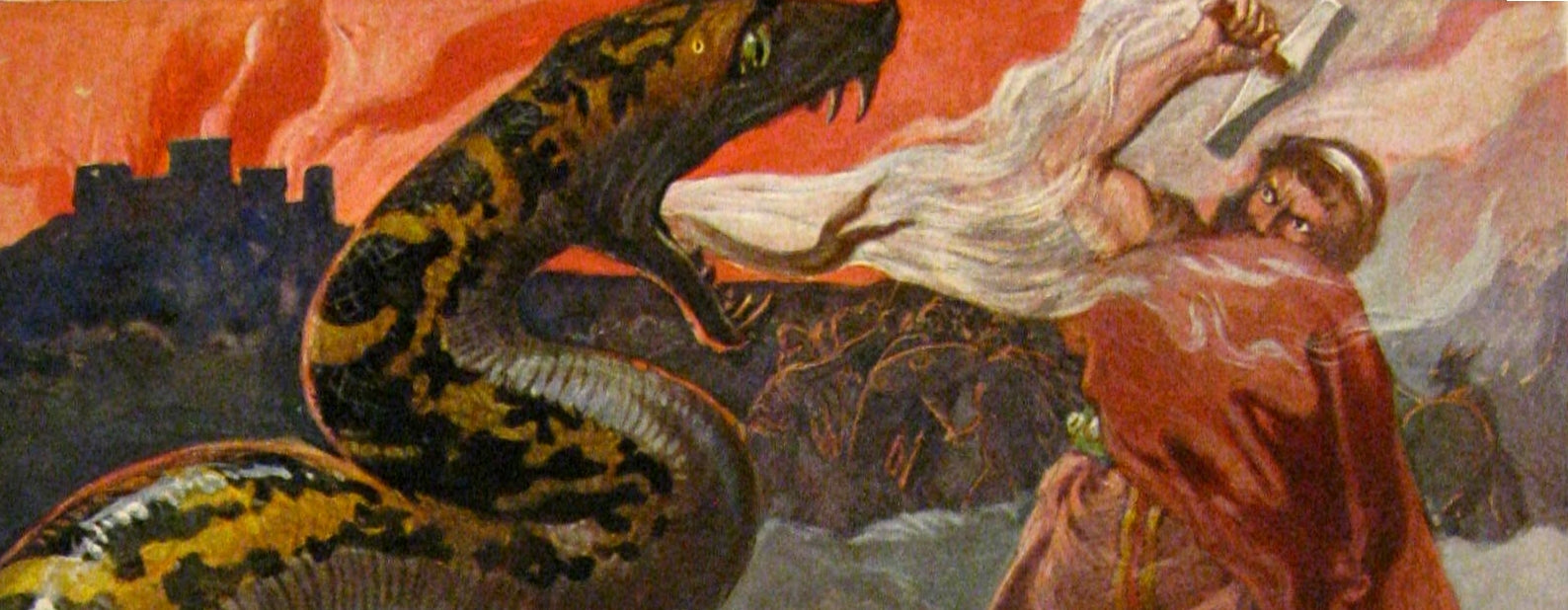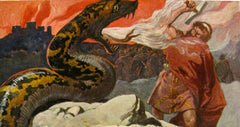on all orders over $100
on all orders over $100

In Norse Mythology Thor was the favourite son of Odin and the god of Thunder. He was one of the most referenced gods in Norse sagas, in addition to being the most worshipped amongst the people of the Viking age.
His name 'Þórr' in old norse translated to 'Thor' in modern English and was the germanic influence for the day 'Thursday'. The influence can also be seen in other languages too, in Danish the day is called 'Torsdag' and in German the day is called 'Donnerstag' which means 'Thunder Day'.

Thor fighting the frost giants - Mårten Eskil Winge, 1872
Extra marital affairs were quite common in Norse Mythology and Odin was no exception. Thor was the product one one such affair between Odin and Jord, who was a mysterious figure, which some historians think was supposed to be a representation of the earth itself.
Thor also had a number of siblings; Baldur, the most beloved of all of the gods, Hodr and Bragi who both had unknown mothers and Ullr, who was the child of Odin and Thor's own wife, Sif. Confusingly this would make Ullr both Thor's half brother and his wife's son.
Although not a blood relative Loki was also taken into the family as a child when he was adopted by Odin. Loki was originally from Jotunheim, the land of the frost giants, however he grew up and spent the majority of his life in Asgard. The two of them had a complicated relationship with Loki's mischievous ways often causing huge problems for Thor, who would then force him to make amends under threat of pain.
With his wife Sif, Thor had two children; Modi and Thrud. He also had one child outside of marriage with a giantess named Jarnsaxa, who some historians believe could have been Sif going by a different name, however this is still debated. Their son was named Magni, however he rarely appeared in the sagas.
Thor was portrayed as a strong and dutiful figure, who was always there to protect Asgard and its people from their enemies. He was an imposing figure with an adonis like physique, who went into battle on a chariot drawn by two goats and wielded his legendary hammer, Mjölnir.
He is often depicted as a 'protector' type character who defends the 'good' peoples from the evil forces of chaos and destruction. It was these traits that lead to his role in the norsemen's culture during the Viking age. It was Thor who they often prayed to in order to ask for protection, hallow their land, or bless a wedding.
In addition to being known as a powerful and feared warrior, Thor was also associated with agriculture and fertility. He famously controlled the thunder and lightning, however also had influence over the rains which were essential to the harvest. It was Thor who was said to have blessed the lands in Iceland which allowed the first pioneers to settle there.
Thor appeared in many norse sagas, and often played an important part in them. In one story, written by Snorri in the Prose Edda, Thor and Hymir were on a fishing trip when they encountered an unexpected catch. Thor was using an ox's head as bait and suddenly felt a sharp pull on his line. Using his immense strength he wrenched the great Midgard serpent, Jormungandr, from the water. The two of them locked gaze and Thor reached for Mjölnir in order to slay the beast, However before he had time a terrified Hymir quickly cut the line and the great snake swam back down into the depths of the ocean.
This encounter was not the last time the two of them would see each other as their fates were locked together in the prophecy of Ragnarok, where they would fight to the death. The events were said to begin with the crumbling of the tree of life, Yggdrasil, and earthquakes which would release Fenrir and Jormungandr. The forces of chaos would then march towards Asgard along the Bifrost being lead by their king, Surt, who wielded a great flaming sword.

Thor fighting Jormungandr - Emil Doepler, 1905
Despite knowing their fate the Gods would meet them in battle and Thor's father, Odin, would lead the charge. He would eventually be killed by the giant wolf, Fenrir, and Thor would fight with Jormungandr. The fighting would be fierce, however with his mighty hammer Thor would manage to bludgeon the beast to death. Unfortunately the wounds sustained during the fight would kill him shortly after due to the fast acting poison from the serpents bite.
These examples were only a couple of the many appearances of Thor in the Norse Mjölnir, and his many encounters with the frost giants of Jotunheim.
Worshiping Thor was very popular in Viking age culture, as previously stated Thor would be praised in time of war when protections was needed, to ensure a good harvest and bless weddings. There have also been many historical finds of Mjölnir pendants which would have been worn around the necks of Viking's in order to seek protection from Thor.
The prevalence of this symbolism is thought to have increased towards the late Viking age when christianity was encroaching on Northern Europe and slowly replacing their native religion and belief systems. The Norsemen would wear a Thor's hammer necklace around their neck in defiance and contrast to the crucifix worn by their Christian counterparts. The majority of these Mjölnir pendants were found in areas that were known to have the highest amounts of Christianisation, further supporting the theory that wearing one was seen as an act of defiance.
Historically accurate replica of a Thor's hammer pendant found in Scania, Sweden
In Norse society there was a kind of 'tier system', a social hierarchy that existed to order and organise themselves into three groups. The first group was the noblemen and kings, followed by the warrior class and finally the farmers and workers. Odin was often seen as a deity of the upper class, with his principal attributes being his wisdom and magical prowess, where as Thor was much more relatable for the common man. His attributes of strength, loyalty and duty resonated with the warrior class of Viking society as he was seen as the archetypal warrior.
By the late Viking age there had been a significant shift in the social dynamics of their societies and the two lower classes had become largely indistinguishable from one another. This in turn increased the popularity of Thor amongst the people and made him the most worshiped of all the Aesir, displacing Odin who had previously occupied the top spot in the hierarchy.
If you enjoyed our article or have anything to add please leave comment below.
Check out some of our handmade Mjölnir jewelry.
Leave a comment